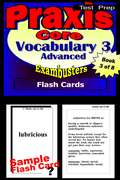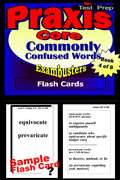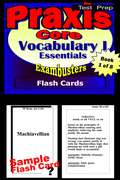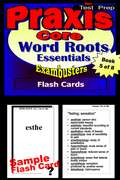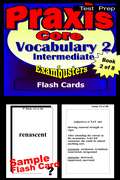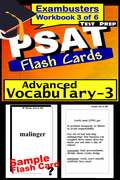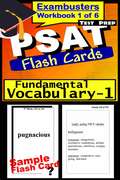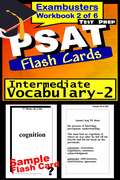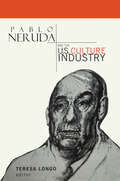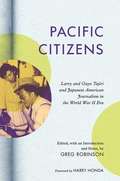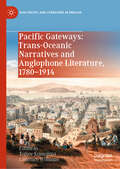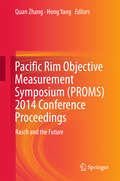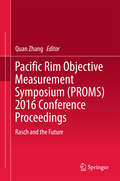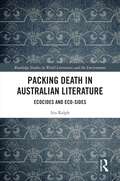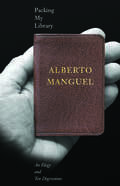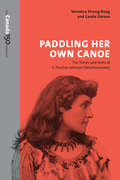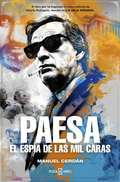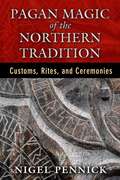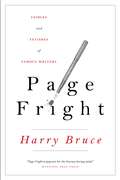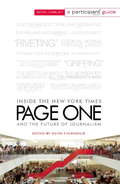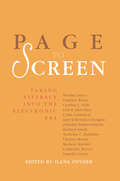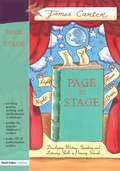- Table View
- List View
PRAXIS Core Test Prep Flash Cards: Advanced Vocabulary (Exambusters PRAXIS Core Workbook #3 of 8)
by Ace Inc.<P><P><i>Advisory: Bookshare has learned that this book offers only partial accessibility. We have kept it in the collection because it is useful for some of our members. Benetech is actively working on projects to improve accessibility issues such as these.</i><P><P> 350 words every well-educated person should know. While you may not hear them every day, they can show up on the PRAXIS 1/PPST test, and understanding them will boost your score. <P><P>Includes sample sentence, part of speech, pronunciation, succinct, easy-to-remember definition, and common synonyms and antonyms. <P>EXAMBUSTERS PRAXIS Prep Workbooks provide comprehensive, fundamental PRAXIS review--one fact at a time--to prepare students to take practice PRAXIS tests. Each PRAXIS study guide focuses on one specific subject area covered on the PRAXIS exam. From 300 to 600 questions and answers, each volume in the PRAXIS series is a quick and easy, focused read. Reviewing PRAXIS flash cards is the first step toward more confident PRAXIS preparation and ultimately, higher PRAXIS exam scores!
PRAXIS Core Test Prep Flash Cards: Commonly Confused Words (Exambusters PRAXIS Core Workbook #4 of 8)
by Ace Inc.<P><P><i>Advisory: Bookshare has learned that this book offers only partial accessibility. We have kept it in the collection because it is useful for some of our members. Benetech is actively working on projects to improve accessibility issues such as these.</i><P><P> Do you know the difference between "fewer" and "less," when to use "it's" or "its," or how to distinguish between "historical" and "historic" or "tortuous" and "torturous?" <P><P>This course contains 500 pairs of commonly confused words, some so frequently misused that their wrong application has become acceptable to many ears. Includes part of speech, pronunciation, simple definition, and usage example. Mastering the differences will improve your written grammar, verbal communication, and most importantly, your PRAXIS 1/PPST test score! <P>EXAMBUSTERS PRAXIS Prep Workbooks provide comprehensive, fundamental PRAXIS review--one fact at a time--to prepare students to take practice PRAXIS tests. Each PRAXIS study guide focuses on one specific subject area covered on the PRAXIS exam. From 300 to 600 questions and answers, each volume in the PRAXIS series is a quick and easy, focused read. Reviewing PRAXIS flash cards is the first step toward more confident PRAXIS preparation and ultimately, higher PRAXIS exam scores!
PRAXIS Core Test Prep Flash Cards: Essential Vocabulary 1 (Exambusters PRAXIS Core Workbook #1 of 8)
by Ace Inc.<P><P><i>Advisory: Bookshare has learned that this book offers only partial accessibility. We have kept it in the collection because it is useful for some of our members. Benetech is actively working on projects to improve accessibility issues such as these.</i><P><P> 500 frequently tested PRAXIS 1/PPST words every college student should know. Perfect for anyone who wants to enrich their vocabulary! Improve your reading comprehension and conversation. <P><P>Includes sample sentence, part of speech, pronunciation, succinct, easy-to-remember definition, and common synonyms and antonyms. <P>EXAMBUSTERS PRAXIS Prep Workbooks provide comprehensive, fundamental PRAXIS review--one fact at a time--to prepare students to take practice PRAXIS tests. Each PRAXIS study guide focuses on one specific subject area covered on the PRAXIS exam. From 300 to 600 questions and answers, each volume in the PRAXIS series is a quick and easy, focused read. Reviewing PRAXIS flash cards is the first step toward more confident PRAXIS preparation and ultimately, higher PRAXIS exam scores!
PRAXIS Core Test Prep Flash Cards: Word Roots (Exambusters PRAXIS Core Workbook #5 of 8)
by Ace Inc.<P><P><i>Advisory: Bookshare has learned that this book offers only partial accessibility. We have kept it in the collection because it is useful for some of our members. Benetech is actively working on projects to improve accessibility issues such as these.</i><P><P> A unique collection of 380 essential Word Roots, Prefixes, and Suffixes, each with up to ten derivative word examples and definitions. Interpret new words without a dictionary. You'll view language from an entirely new perspective, and raise your PRAXIS 1/PPST test score too! <P><P> EXAMBUSTERS PRAXIS Prep Workbooks provide comprehensive, fundamental PRAXIS review--one fact at a time--to prepare students to take practice PRAXIS tests. Each PRAXIS study guide focuses on one specific subject area covered on the PRAXIS exam. From 300 to 600 questions and answers, each volume in the PRAXIS series is a quick and easy, focused read. Reviewing PRAXIS flash cards is the first step toward more confident PRAXIS preparation and ultimately, higher PRAXIS exam scores!
PRAXIS Core Test Prep IFlash Cards: Intermediate Vocabulary 2 (Exambusters PRAXIS Core Workbook #2 of 8)
by Ace Inc.<P><P><i>Advisory: Bookshare has learned that this book offers only partial accessibility. We have kept it in the collection because it is useful for some of our members. Benetech is actively working on projects to improve accessibility issues such as these.</i><P><P> 350 frequently tested PRAXIS 1/PPST words every college student should know. Perfect for anyone who wants to enrich their vocabulary! Improve your reading comprehension and conversation. Includes sample sentence, part of speech, pronunciation, succinct, easy-to-remember definition, and common synonyms and antonyms.<P> <P>EXAMBUSTERS PRAXIS Prep Workbooks provide comprehensive, fundamental PRAXIS review--one fact at a time--to prepare students to take practice PRAXIS tests. Each PRAXIS study guide focuses on one specific subject area covered on the PRAXIS exam. From 300 to 600 questions and answers, each volume in the PRAXIS series is a quick and easy, focused read. Reviewing PRAXIS flash cards is the first step toward more confident PRAXIS preparation and ultimately, higher PRAXIS exam scores!
PSAT Test Prep Flash Cards: Advanced Vocabulary (Exambusters PSAT Workbook #3)
by Ace Inc.<P><P><i>Advisory: Bookshare has learned that this book offers only partial accessibility. We have kept it in the collection because it is useful for some of our members. Benetech is actively working on projects to improve accessibility issues such as these.</i><P><P> 350 frequently tested PSAT/NMSQT words every college freshman should know. Perfect for anyone who wants to enrich their vocabulary! Improve your reading comprehension and conversation.<P><P> Includes sample sentence, part of speech, pronunciation, succinct, easy-to-remember definition, and common synonyms and antonyms. <P>EXAMBUSTERS PSAT Prep Workbooks provide comprehensive, fundamental PSAT review--one fact at a time--to prepare students to take practice PSAT tests. Each PSAT study guide focuses on one specific subject area covered on the PSAT exam. From 300 to 600 questions and answers, each volume in the PSAT series is a quick and easy, focused read. Reviewing PSAT flash cards is the first step toward more confident PSAT preparation and ultimately, higher PSAT exam scores!
PSAT Test Prep Flash Cards: Fundamental Vocabulary - 1 (Exambusters PSAT Workbook #1 of 6)
by Ace Inc.<P><P><i>Advisory: Bookshare has learned that this book offers only partial accessibility. We have kept it in the collection because it is useful for some of our members. Benetech is actively working on projects to improve accessibility issues such as these.</i><P><P> 300 basic words every high school freshman should know. Includes part of speech, pronunciation, succinct, easy-to-remember definition, and common synonyms and antonyms.<P><P> <P>EXAMBUSTERS PSAT Prep Workbooks provide comprehensive, fundamental PSAT review--one fact at a time--to prepare students to take practice PSAT tests. Each PSAT study guide focuses on one specific subject area covered on the PSAT exam. From 300 to 600 questions and answers, each volume in the PSAT series is a quick and easy, focused read. Reviewing PSAT flash cards is the first step toward more confident PSAT preparation and ultimately, higher PSAT exam scores!
PSAT Test Prep Flash Cards: Intermediate Vocabulary 2 (Exambusters PSAT Workbook #2 of 6)
by Ace Inc.<P><P><i>Advisory: Bookshare has learned that this book offers only partial accessibility. We have kept it in the collection because it is useful for some of our members. Benetech is actively working on projects to improve accessibility issues such as these.</i><P><P> 500 frequently tested PSAT/NMSQT words every high school student should know. Perfect for anyone who wants to enrich their vocabulary! Improve your reading comprehension and conversation.<P><P> Includes sample sentence, part of speech, pronunciation, succinct, easy-to-remember definition, and common synonyms and antonyms. <P>EXAMBUSTERS PSAT Prep Workbooks provide comprehensive, fundamental PSAT review--one fact at a time--to prepare students to take practice PSAT tests. Each PSAT study guide focuses on one specific subject area covered on the PSAT exam. From 300 to 600 questions and answers, each volume in the PSAT series is a quick and easy, focused read. Reviewing PSAT flash cards is the first step toward more confident PSAT preparation and ultimately, higher PSAT exam scores!
Pablo Neruda and the U.S. Culture Industry (Hispanic Issues)
by Teresa LongoIn this compelling collection, Teresa Longo gathers a diverse group of critical and poetic voices to analyze the politics of packaging and marketing Neruda and Latin American poetry in general in the United States.
Pablo Picasso (SparkNotes Biography Guide)
by SparkNotesPablo Picasso (SparkNotes Biography Guide) Making the reading experience fun! SparkNotes Biography Guides examine the lives of historical luminaries, from Alexander the Great to Virginia Woolf. Each biography guide includes:An examination of the historical context in which the person lived A summary of the person&’s life and achievements A glossary of important terms, people, and events An in-depth look at the key epochs in the person&’s career Study questions and essay topics A review test Suggestions for further reading Whether you&’re a student of history or just a student cramming for a history exam, SparkNotes Biography guides are a reliable, thorough, and readable resource.
Pacemaker American Literature
by FearonDesigned to spark students' interest and help them realize their fullest potential, this multicultural collection of short stories, essays, autobiographies, and poems is organized by theme, including suspense, adventure, and conflict. <p><p> Lexile Level 710 Reading Level 3-4 Interest Level 6-12
Pacific Citizens: Larry and Guyo Tajiri and Japanese American Journalism in the World War II Era
by Greg Robinson Harry HondaOffering a window into a critical era in Japanese American life, Pacific Citizens collects key writings of Larry S. Tajiri, a multitalented journalist, essayist, and popular culture maven. He and his wife, Guyo, who worked by his side, became leading figures in Nisei political life as the central purveyors of news for and about Japanese Americans during World War II, both those confined in government camps and others outside. The Tajiris made the community newspaper the Pacific Citizen a forum for liberal and progressive views on politics, civil rights, and democracy, insightfully addressing issues of assimilation, multiracialism, and U.S. foreign relations. Through his editorship of the Pacific Citizen as well as in articles and columns in outside media, Larry Tajiri became the Japanese American community's most visible spokesperson, articulating a broad vision of Nisei identity to a varied audience. In this thoughtfully framed and annotated volume, Greg Robinson interprets and examines the contributions of the Tajiris through a selection of writings, columns, editorials, and correspondence from before, during, and after the war. Pacific Citizens contextualizes the Tajiris' output, providing a telling portrait of these two dedicated journalists and serving as a reminder of the public value of the ethnic community press.
Pacific Gateways: Trans-Oceanic Narratives and Anglophone Literature, 1780–1914 (Asia-Pacific and Literature in English)
by Laurence Williams Tomoe Kumojima“‘Who is … the Proust of the Paphuans?’, Saul Bellow infamously inquired, as if this vast expanse were too small, scattered and backward to deserve consideration. In response to this challenge, Pacific Gateways seeks to define a new (if provisional) canon. This diverse, insightful and compelling collection applies ethnographic perspectives (contact zone, participant-testimony, indigeneity) to a diverse range of genres (romance, travelogue, memoir) to demonstrate how the Pacific already prefigures and generates later networks of global exchange. It offers not retrospect into a distant past, but intimations of possible futures, as a portal into alternative forms of planetary consciousness.” (Steve Clark) This book explores the entanglements of Anglophone literature with Pacific geographies, histories, and cultures during the long nineteenth century, giving a transpacific context to Victorian writers including Dickens, Kingston, Stevenson, and Trollope, and setting them alongside Pacific Rim writers such as Bret Harte, Lafcadio Hearn, Joseph Heco, and Yei Theodora Ozaki. The chapters focus upon the physical and imaginative “gateways” produced by Western technology, including the port city, the steamship, telegraph lines, and the networks of international trade and finance. These Pacific gateways shape the development of a “transpacific consciousness” in Anglophone literature, whose modes of exchange and patterns of thought can still be seen in modern-day attitudes to the region. The book aims to present a polyglot and cross-cultural history of Anglophone literature in the Pacific, in which Anglo-American imperialism coexists with established intra-Asian networks. Chapter 1 is available open access under a Creative Commons Attribution 4.0 International License via link.springer.com
Pacific Rim Objective Measurement Symposium (PROMS) 2012 Conference Proceeding
by Hong Yang Quan ZhangEntrusted by the Board of Management of the Pacific Rim Objective Measurement Symposium (PROMS), PROMS2012 is held in Jiaxing, China from August 6-9, 2012. Over the past years, PROMS has been hosted in many parts of the Pacific Rim, in Singapore, Malaysia, Hong Kong, Taiwan and Tokyo, which has greatly promoted the research of and contributed to the development of Rasch Model in one way or another. As early as in 1980s, the ideas and concepts regarding IRT was first introduced into China by Prof. Gui Shichun, my Ph.D supervisor, and it is Prof. Gui who first conducted with great success the ten-year long (1990-1999) Equating Project for Matriculation English Test (MET) in China. MET is the most influential entrance examination for higher education administered annually to over 3.3 million candidates then. The Equating Project won recognition by Charles Alderson and other foreign counterparts during 1990s. Academically, those were Good Old Days for Chinese testing experts and psychometricians. Then for certain reasons, the equating practice abruptly discontinued. Therefore, in China nowadays, the application of IRT-based software like BILOG, Parscale, Iteman 4 and others to real testing problem solving is confined to an extremely small 'band' of people. In this sense, PROMS2012 meets an important need in that it provides an excellent introduction of IRT and its application. And anyone who is seriously interested in research and development in the field of psychometrics or language testing will find such a symposium and related workshops to be an excellent source of information about the application of Rasch Model. PROMS2012 focuses on recent advances in objective measurement and provides an international forum on both the latest research in using Rasch measurement and non-Rasch practice.
Pacific Rim Objective Measurement Symposium (PROMS) 2016 Conference Proceedings: Rasch And The Future
by Quan ZhangThis book gathers original studies presented at the PROMS 2016 conference on Rasch theories and Rasch-based applications. It provides significant examples used to address practical measurement problems across a range of disciplines, including: Classic Testing Theory (CTT), Item Response Theory (IRT), philosophy of measurement, dimensionality, the role of fit statistics and research, business and industrial applications, health-related research and the latest Rasch-based computer software. PROMS welcomes empirical and theoretical studies and workshops, preferably with an emphasis on the Rasch model. Special attention is paid to manuscripts submitted by non-native English-speaking authors from Pacific Rim countries, regions and beyond. PROMS 2016 (Pacific Rim Objective Measurement Symposium) was held July 30-August 3, 2016 in Xi’an, China. The goal of the conference was to bring together researchers, scholars and professors from research institutes, universities, hospitals, business and management sectors, as well as professional practitioners, to exchange and share ideas, problems and solutions regarding the multifaceted aspects of the Rasch model and on the much debated yet highly topical issues of objective assessment.
Packing Death in Australian Literature: Ecocides and Eco-Sides (Routledge Studies in World Literatures and the Environment)
by Iris RalphPacking Death in Australian Literature: Ecocides and Eco-Sidesaddresses Australian Literature from ecocritical, animal studies, plantstudies, indigenous studies, and posthumanist critical perspectives. Thebook’s main purpose is twofold: to bring more sustained attention to environmental,vegetal, and animal rights issues, past and present, and todo that from within the discipline of literary studies. Literary studies inAustralia continue to reflect disinterest or not enough interest in criticalengagements with the subjects of Australia’s oldest extant environmentsand other beings beside humans. Packing Death in Australian Literature:Ecocides and Eco-Sides foregrounds the vegetal and nonhumananimal populations and contours of Australian Literature. Critical studiesrelied on in Packing Death in Australian Literature: Ecocides andEco-Sides include books by CA. Cranston and Robert Zeller, Simon C.Estok, Bill Gammage, Timothy Morton, Bruce Pascoe, Val Plumwood,Kate Rigby, John Ryan, Wendy Wheeler, and Cary Wolfe. The selectedliterary texts include work by Merlinda Bobis, Eric Yoshiaki Dando,Nugi Garimara, Francesca Rendle-Short, Patrick White, and Evie Wyld.
Packing My Library: An Elegy and Ten Digressions
by Alberto ManguelA best-selling author and world-renowned bibliophile meditates on his vast personal library and champions the vital role of all libraries In June 2015 Alberto Manguel prepared to leave his centuries-old village home in France’s Loire Valley and reestablish himself in a one-bedroom apartment on Manhattan’s Upper West Side. Packing up his enormous, 35,000‑volume personal library, choosing which books to keep, store, or cast out, Manguel found himself in deep reverie on the nature of relationships between books and readers, books and collectors, order and disorder, memory and reading. In this poignant and personal reevaluation of his life as a reader, the author illuminates the highly personal art of reading and affirms the vital role of public libraries. Manguel’s musings range widely, from delightful reflections on the idiosyncrasies of book lovers to deeper analyses of historic and catastrophic book events, including the burning of ancient Alexandria’s library and contemporary library lootings at the hands of ISIS. With insight and passion, the author underscores the universal centrality of books and their unique importance to a democratic, civilized, and engaged society.
Paddling Her Own Canoe: The Times and Texts of E. Pauline Johnson (Tekahionwake)
by Veronica Strong-Boag Carole GersonFrequently dismissed as a 'nature poet' and an 'Indian Princess' E. Pauline Johnson (1861-1913) was not only an accomplished thinker and writer but a contentious and passionate personality who 'talked back' to Euro-Canadian culture. Paddling Her Own Canoe is the only major scholarly study that examines Johnson's diverse roles as a First Nations champion, New Woman, serious writer and performer, and Canadian nationalist. A Native advocate of part-Mohawk ancestry, Johnson was also an independent, self-supporting, unmarried woman during the period of first-wave feminism. Her versatile writings range from extraordinarily erotic poetry to polemical statements about the rights of First Nations. Based on thorough research into archival and published sources, this volume probes the meaning of Johnson's energetic career and addresses the complexities of her social, racial, and cultural position. While situating Johnson in the context of turn-of-the-century Canada, the authors also use current feminist and post-colonial perspectives to reframe her contribution. Included is the first full chronology ever compiled of Johnson's writing. Pauline Johnson was an extraordinary woman who crossed the racial and gendered lines of her time, and thereby confounded Canadian society. This study reclaims both her writings and her larger significance.
Paesa: El espía de las mil caras
by Manuel CerdánLa apasionante y enigmática vida de Francisco Paesa, uno de los espías más legendarios de las últimas décadas, escrita por el periodista que le cazó en París. Cuando el 2 de julio de 1998 salió publicada en la prensa la esquela de Francisco Paesa, fallecido en Tailandia, muchos respiraron. Por fin desaparecía del mapa el espía que, entre otras cosas, había negociado la entrega de Luis Roldán al gobierno español en el famoso caso de los papeles de Laos. Sin embargo, aquel muerto estaba vivo. Aquella esquela no era más que la penúltima jugada del espía español más importante de las últimas décadas. No tenía licencia para matar como James Bond, pero vivió con la opulencia de 007: bebiendo champán Dom Perignon y acompañado de hermosas mujeres. No era un personaje de ficción, pero se comportaba como los héroes de las novelas de John Le Carré. Siempre con una causa judicial pendiente, siempre con la policía pisándole los talones, Paesa ha vivido al filo de la legalidad una existencia trepidante: estafador del presidente ecuatoguineano en 1968, traficante de armas internacional, vendedor de misiles a ETA -que culmina con la célebre Operación Sokoa-, mediador en el caso GAL intercediendo a una testigo protegida por Garzón, agente secreto del Ministerio del Interior en los años más oscuro del felipismo. Una historia trepidante que ha inspirado la última película de Alberto Rodríguez, director de La isla mínima.
Pagan Magic of the Northern Tradition: Customs, Rites, and Ceremonies
by Nigel PennickA practical guide to the magical history, customs, and practices of pre-Christian Northern Europe • Details the everyday magic of the Northern Tradition, including household magic, protection spells, and the significance of the days of the week • Explores direct natural magic, such as shapeshifting and soul travel, and talismanic or sigil magic, including runes and rituals to unlock the power of crafted objects • Explains how many of these customs continue to the present day In the pre-Christian societies of Northern Europe, magic was embedded in the practical skills of everyday life. Everything in Nature was ensouled with an inner spirit, as was anything made by hand. People believed in magic because it worked and because it was part of the functionality of their day-to-day lives. Many of these practical observances and customs continue to the present day as rural traditions, folk customs, household magic, and celebrations of the high and holy days of the calendar. Exploring the magical pagan traditions of the people now called Celtic, Germanic, Scandinavian, Slavonic, and Baltic, Nigel Pennick examines the underlying principle of the Northern Tradition--the concept of Wyrd--and how it empowers the arts of operative magic, such as direct natural magic and talismanic or sigil magic. Through direct natural magic, individuals can shape shift, journey out of the body, or send one of their three souls (fylgia or “fetch”) ahead of them. Sigil magic involves the powers contained in objects, which can be channeled after the appropriate ritual. Runes are the most powerful sigils in the Northern Tradition and were used to ward off illness, danger, hostile magic, and malevolent spirits. Emphasizing the importance of the cycles of Nature to the tradition, Pennick explores the eightfold sun dials and the four ways the solar year is defined. He looks at the days of the week and their symbolic association with different deities as well as why particular acts are performed on certain days and what the customary lucky and unlucky days are. He also examines sacred spaces, household magic, protection spells, and the role of music in the Northern Tradition. Explaining all the traditional holidays and activities necessary to honor them, Pennick shows how anyone can participate authentically in the magic of the Northern Tradition if they take care to do things properly, with respect, and on the right day.
Pagan Virtue in a Christian World: Sigismondo Malatesta and the Italian Renaissance
by Anthony F. D'EliaIn 1462 Pope Pius II performed the only reverse canonization in history, damning a living man to an afterlife of torment. What had Sigismondo Malatesta, Lord of Rimini and a patron of the arts, done to merit this fate? Anthony D'Elia shows how the recovery of classical literature and art during the Italian Renaissance led to a revival of paganism.
Page Fright: Foibles and Fetishes of Famous Writers
by Harry BruceA witty round-up of writers' habits that includes all the big names, such as Dickens, Flaubert, Tolstoy, Hemingway. At public events readers always ask writers how they write. The process fascinates them. Now they have a very witty book that ranges around the world and throughout history to answer their questions. All the great writers are here -- Dickens, dashing off his work; Henry James dictating it; Flaubert shouting each word aloud in the garden; Hemingway at work in cafés with his pencil. But pencil or pen, trusty typewriter or computer, they all have their advocates. Not to mention the writers who can only keep the words flowing by writing naked, or while walking or listening to music -- and generally obeying the most bizarre superstitions. On Shakespeare's works: "Fantastic. And it was all done with a feather!" -- Sam Goldwyn. "I write nude, seated on a thick towel, and perhaps with a second towel around me." -- Paul West. "I've never heard of anyone getting plumber's block, or traffic cop's block." -- Allan Gurganus. "I'm a drinker with a writing problem." -- Brendan Behan.
Page One: Inside The New York Times and the Future of Journalism
by Participant Media David FolkenflikThe news media is in the middle of a revolution. Old certainties have been shoved aside by new entities such as WikiLeaks and Gawker, Politico and the Huffington Post. But where, in all this digital innovation, is the future of great journalism? Is there a difference between an opinion column and a blog, a reporter and a social networker? Who curates the news, or should it be streamed unimpeded by editorial influence? Expanding on Andrew RossiOCOs ?rivetingOCO film ("Slate"), David Folkenflik has convened some of the smartest media savants to talk about the present and the future of news. Behind all the debate is the presence of the New York Times, and the inside story of its attempt to navigate the new world, embracing the immediacy of the web without straying from a commitment to accurate reporting and analysis that provides the paper with its own definition of what it is there to showcase: all the news thatOCOs fit to print. "
Page to Screen: Taking Literacy into the Electronic Era (Studies In Education Ser.)
by Ilana SnyderHypertext, e-mail, word processing: electronic technologies have revolutionized textual practices. How does language on screen work differently from language on the page? What new literacy skills are needed and how do we teach them?Page to Screen collects some of the best contemporary thinkers in the field of technology and literacy. They analyze the potential of the new forms of text, the increased emphasis on visual communication, new forms of rhetoric, learning in the age of global communication networks and new approaches to storytelling.Page to Screen is compelling reading for anyone interested in Literacy Education, Language Studies, English, Library Studies, Multimedia and Communication Studies.International contributors include Gunther Kress, Cynthia Selfe, Gail E. Hawisher and Colin Lankshear.
Page to Stage: Developing Writing, Speaking And Listening Skills in Primary Schools
by James CarterAn exciting and creative approaches that links literacy and oracy in a way that children will enjoy. Performing poetry is also proven to boost self-esteem.Includes:* Audio downloadable resources with recordings of published poets and children performing their own work* Activities to develop speaking and listening skills* Model poems from which to work* Guidelines for progressing through the writing and performance process* A three stage model: preparation -- writing -- performing
